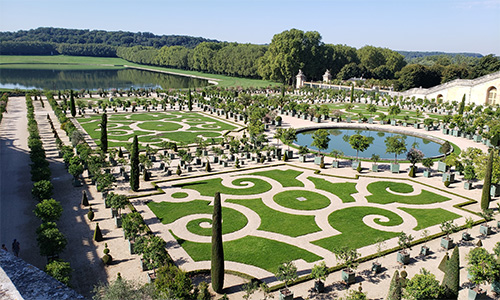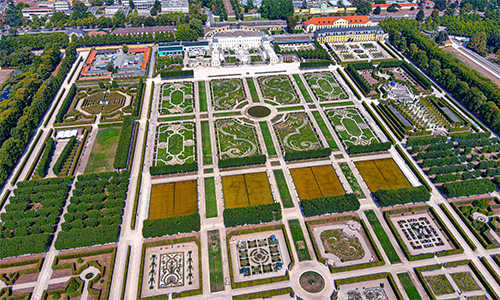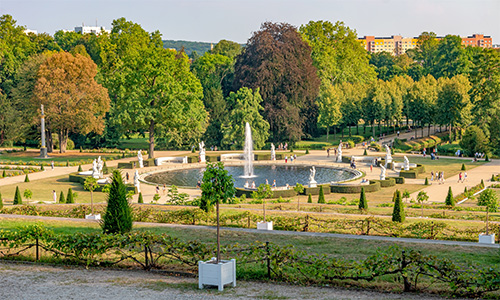The Splendor of Baroque Gardens – A Journey through History and Design
Imagine a place where historical splendor and artistic design blend in perfect harmony – this is the world of Baroque gardens. This page takes you on an exquisite journey into the opulent past and majestic architecture of Baroque gardens, whose influences continue to inspire the most sophisticated garden designs of our time.
Baroque gardens are not only masterpieces of garden art but also symbols of unparalleled elegance and refined living. They reflect the aesthetic and luxury of the 17th and 18th centuries, an era when garden design was considered the highest form of artistic expression.
Embark on a discovery of the fascinating history and artistic design of these gardens. Let yourself be enchanted by the sublime beauty and timeless elegance of Baroque gardens, which still epitomize sophistication and exclusivity today. Discover how the perfect symmetry and magnificent design of these gardens can be realized in your own outdoor spaces. Let yourself be inspired to achieve luxury and nature in a harmonious symbiosis in your own garden world.
The History of Baroque Gardens
Baroque gardens emerged in the 17th century during the Baroque era, a period renowned for its extravagant architecture and artistic opulence. These gardens were not only expressions of their owners' personal tastes but also symbols of power and prestige.
French Inspiration
Undoubtedly, the most famous Baroque garden is the Gardens of Versailles, designed by the visionary landscape architect André Le Nôtre. Versailles stands as the ultimate jewel of French garden artistry and a symbol of royal power and grandeur. With its geometric rigor and impressive symmetry, this garden set the standard for Baroque gardens across Europe.
Geometric Perfection:
The Gardens of Versailles are a masterpiece of symmetry and order. Its meticulously planned
Parterres de Broderie, intricately trimmed hedges, and perfectly aligned avenues create a sense
of endless expanse and majestic tranquility.Grand Canal and Water Features:
Another highlight is the Grand Canal, which forms the central axis of the garden and provides a grand backdrop for spectacular water displays. The elaborate fountains and water basins are technical masterpieces, showcasing the pinnacle of Baroque engineering.Symbolism and Allegory:
Every part of the garden is infused with symbolic significance. The statues and sculptures narrate mythological tales and glorify the virtues and triumphs of the Sun King, Louis XIV.
Italian Influence
In Italy, Baroque gardens developed their own dramatic dynamism by combining Renaissance elements with a wealth of water features and sculptures. These gardens are true natural stage sets that impress with their theatrical effect.
Dramatic Water Features:
Italian Baroque gardens such as the Gardens of Villa d'Este in Tivoli are renowned for their spectacular water displays. Cascades, fountains, and water organs create a vibrant and dynamic spectacle that enchants the senses.Sculptural Masterpieces:
The gardens abound with statues and sculptures that are not only decorative but also narrative. These artistic figures depict gods, heroes, and mythological scenes, transforming the garden into a lively narrative.Terraces and Viewpoints:
Through the skillful use of terraces and changes in elevation, Italian Baroque gardens offer breathtaking views and changing perspectives that enrich and intensify the visitor's experience.
Spread Across Europe
From France and Italy, the Baroque garden style quickly spread to Germany, Austria, and beyond, giving rise to magnificent gardens such as the Schönbrunn Palace Garden in Vienna.
Germany and Austria
In these countries, the principles of Baroque gardens found enthusiastic followers. Particularly notable are the Herrenhausen Gardens in Hanover and the Schönbrunn Palace Garden in Vienna, an imperial residence considered a prime example of the fusion of French and Italian garden art. The history of the Schönbrunn Palace Garden dates back to the 17th century when Emperor Leopold I commissioned the construction of a splendid hunting lodge and accompanying gardens. Later, during the reign of Maria Theresa, the garden was further developed according to the plans of architect Johann Ferdinand Hetzendorf von Hohenberg, achieving its current Baroque form.
Expansive Parterres:
The expansive, symmetrically laid-out parterres bear witness to French garden artistry and offer an impressive axis that leads the eye to the horizon.Majestic Avenues:
The majestic avenues, lined with magnificent statues and hedges, create an atmosphere of grandeur and majesty, turning a stroll through the garden into a royal experience.Impressive Sculptures:
Impressive sculptures and fountain installations, inspired by Greek and Roman mythology, add an additional dimension to the gardens and tell stories of power and triumph.
England and Scandinavia
North of Central Europe, Baroque garden elements also found their way into the design of royal and noble estates. While England later became known for the English landscape garden, initially, its gardens incorporated Baroque structures and forms. The famous garden of Hampton Court, originally laid out by Cardinal Wolsey and later taken over by Henry VIII, shows a mix of Italian and French influences and represents one of the country's most splendid garden estates.
- Formal Gardens:
In England, Baroque elements such as symmetrical hedges and ornamental parterres were adopted on a grand scale.
These gardens served as representative spaces for social gatherings and courtly festivities.
- Nordic Adaptation:
In Scandinavia, Baroque principles were integrated into local garden culture,
with the strict geometry and splendor of plant arrangements enduring the harsher climatic conditions.
Royal residences like Drottningholm Palace in Sweden impressively demonstrate how the Baroque style
was applied in northern latitudes.
Symbolism of Power
Wherever Baroque gardens were established, they served as symbols of power and wealth for their owners. They were not only places of relaxation and enjoyment but also venues for social events, festivities, and diplomatic receptions. The splendid design and meticulous maintenance of these gardens reflected the high status and cultural sophistication of their owners.
Representative Function:
The gardens acted as a stage for demonstrating wealth and influence. The elaborate layouts and artistic elements were strategically employed to impress visitors and solidify political alliances.Cultural Centers:
Baroque gardens were often part of a larger cultural and intellectual network. They housed not only plants and sculptures but also concerts, theatrical performances, and scientific experiments, fostering intellectual exchange and cultural development.
The Structure of a Baroque Garden
Baroque gardens are masterpieces of garden art, impressing with their strict geometry and detailed design. Every aspect of a Baroque garden is meticulously planned to fulfill both aesthetic and symbolic purposes.
Axes and Symmetric:
Baroque gardens are characterized by their clear structure and symmetrical layout. The main axes lead to central focal points like fountains or pavilions, creating a sense of harmony and order. These axes not only enhance the aesthetic appeal but also symbolize human control and mastery over nature. An exemplary case of this mastery in planning is the Garden of Versailles, where the main axis stretches over kilometers, directing the view towards the magnificent palaceParterres:
These meticulously trimmed beds are often filled with colorful gravel or low-growing plants that form ornamental patterns reminiscent of intricate embroidery. These patterns are not only visually appealing but also often symbolically charged to illustrate stories or virtues. The parterres at Versailles and Schönbrunn Palace are outstanding examples of this attention to detail and the ability to transform gardens into living works of art.Water Features and Fountains:
Impressive water features and fountains are central elements of Baroque gardens. These water elements are not only decorative but also technical marvels that enrich the garden with lively movement and refreshing sound. The elaborate fountains of Versailles, such as the Latona Fountain and the Apollo Fountain, are true hydraulic wonders symbolizing the king's dominion over nature.Sculptures and Architecture:
Sculptures and architectural elements like staircases, pavilions, and orangeries add an extra dimension to the garden, often telling mythological stories. These elements are carefully placed to provide visitors not only with visual pleasure but also intellectual stimulation through their allegorical meanings. The marble sculptures at Schönbrunn Palace and the magnificent pavilions at Herrenhausen are excellent examples of how art and nature blend in a Baroque garden.
Overall, Baroque gardens, with their comprehensive and thoughtful design, are more than just places of relaxation. They are expressions of the highest form of artistic and technical skills, offering visitors an experience that delights both the eye and the mind.
Baroque gardens are more than historical relics; they are living testimonies of an era that emphasized luxury and beauty. These gardens symbolize a time when garden design was not just a matter of taste but also an expression of power, culture, and sophistication. They serve as an inspiration for modern garden design and remind us how art and nature can coexist in perfect harmony.
Baroque gardens impress with their masterful geometry, precisely arranged plants, and artistic details that transport every visitor to a world of aesthetics and luxury. The significance of these gardens today lies not only in their historical and cultural relevance but also in their ability to convey timeless beauty and elegance.
Baroque Elements in the Modern Garden
Axis System and Symmetry
The clear structure and symmetrical arrangement of Baroque gardens can also be implemented in private gardens. Start with a main axis that leads from the house into the garden, directing the view to a central point, such as a fountain or statue. This main axis can be complemented by smaller axes that connect various garden areas. Symmetrically arranged beds and paths create a harmonious overall picture.
Parterres
To recreate the intricate patterns of parterres in your own garden, you can design beds with colorful gravel or low-growing plants. Use boxwood hedges to define the edges of the beds and create complex, embroidery-like patterns. These beds can be filled with colorful flowers such as tulips or begonias to produce vibrant colors and patterns.
Bosketts and Hedges
Densely planted hedges and bosketts can serve as green walls in private gardens, creating different garden spaces. Use yew or boxwood hedges to define paths and intimate areas. Within these areas, you can place sculptures, seating areas, or small water features to create surprises and tranquil oases.
Water Features and Fountains
A central water feature or fountain can serve as the main attraction in a Baroque-inspired garden. Modern fountain installations come in various styles and sizes and can be easily integrated into the garden. The gentle sounds of water and the reflective surfaces contribute to a soothing atmosphere and add a touch of elegance to the garden.
Sculptures and Architecture
Sculptures and architectural elements such as pavilions, staircases, or pergolas can add an extra dimension to the garden. Place statues at strategic points to create focal points and enhance the visual depth of the garden. A small pavilion or arbor can serve as a retreat and enrich the garden with a historical flair.
Conclusion
The timeless elegance and detailed craftsmanship of Baroque gardens provide a refined source of inspiration for anyone looking to transform their garden into a sanctuary of luxury and beauty. By integrating elements such as symmetrical axes, artistic parterres, dense hedges, impressive water features, and elegant sculptures into your garden, you can bring to life the magnificent grace of Baroque gardens in your outdoor space. Draw inspiration from the sublime aesthetics and harmonious design of these historical masterpieces and create a garden that is both timeless and unique.
In our exclusive shop, you will find a curated selection of exquisite garden furniture, artistic fountains and water features, elegant stair and pathway decorations, and masterfully crafted sculptures that can be customized to your preferences. Give your garden a distinctive and stylish charm that brings the opulent splendor of Baroque gardens into your private oasis.
Further Reading
Explore our upcoming articles to discover how you can design your Baroque garden with luxurious garden furniture, decorations, fountains and water features, garden houses, pavilions, and sculptures from Casa Padrino. Be inspired by our exclusive offerings and learn how our products can help you create an unparalleled atmosphere of elegance and luxury.
If you require personal assistance, we are available by phone and email to provide guidance. Discover the world of Casa Padrino and turn your dream of a luxurious Baroque garden into reality.








